Your personal brand is how you present yourself to the world, especially in a professional setting. It’s what people think of when they see your name and the impression you leave behind. Your personal brand is more important than ever, and LinkedIn is the perfect platform to showcase it. It’s not just a social media page – it’s a place where you can build a reputation, connect with potential employers, and demonstrate your expertise.
So how do you make sure your LinkedIn profile reflects your personal brand in the best way possible? Here’s how you can stand out on LinkedIn:
Quick links
1. Make your headline count
Your headline is one of the first things people see. Instead of just using your current job title, think of it as your elevator pitch. Use keywords that fit your industry or the job you want. For example, instead of "Payroll Officer," you could try "Specialist in Payroll Processing & Compliance." This quickly shows what you do and what you bring to the table.
2. Update your profile picture and background
A clear, professional headshot is essential. In fact, profiles with a professional photo get 21 times more profile views and are 36 times more likelyto receive a message compared to those without one. Your photo helps create a great first impression and can set the tone for how potential employers or connections perceive you. Make sure your headshot is current, well-lit, and that you’re dressed appropriately for your industry.
Your background image is another opportunity to showcase your personal brand. Choose something that represents your industry or reflects your professional goals – this visual element can help make your profile stand out even more.
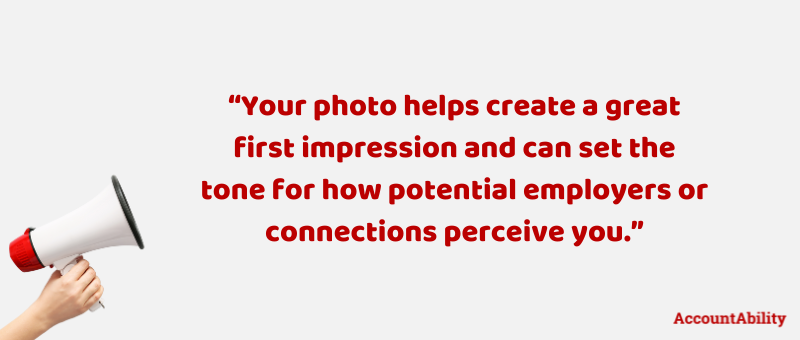
3. Write a strong ‘About’ section
The ‘About’ section is your chance to share your story. Keep it engaging – highlight your career journey, key skills, and what excites you about your work. Use industry-relevant keywords, and don’t be afraid to show some personality! A good 'About' section can make a real impact.
Senior Consultant, Lucy McDonald says "Use your "about" section to tell a story about you and your career history. Whilst this is a professional platform, I like to see a bit of personality so I can get a better feel for who you are as a person and what drives you in your career."
4. Focus on achievements, not just tasks
When listing your experience, don’t just focus on your responsibilities – highlight your achievements. Using bullet points and focusing on results makes it easier for employers to see the value you bring. Where possible, back up your accomplishments with quantitative data (e.g., "Processed payroll for 500+ employees with 99.9% accuracy" or "Reduced processing time by 20%").
Including specific numbers and metrics makes your achievements more credible and impressive. In fact, resumes with quantifiable results are 40% more likely to grab the attention of hiring managers. Quantitative data shows the direct impact you’ve made, providing potential employers with concrete evidence of your skills.
The STAR method
To help structure your achievements, consider using the STAR method (Situation, Task, Action, Result). This approach helps you clearly explain the context, what you were responsible for, the actions you took, and the result of your work. For example, if you automated a payroll process, describe the situation, the steps you took to improve efficiency, and the measurable outcome (e.g., "Reduced payroll processing time by 30%").
By combining quantitative data with the STAR method, your LinkedIn profile will present your accomplishments in a clear, compelling way that makes it easy for employers to see your value.
For further information on the STAR method and how to use it, read our blog 'Nailing your interview: Unlock effective communication with the STAR Method'.
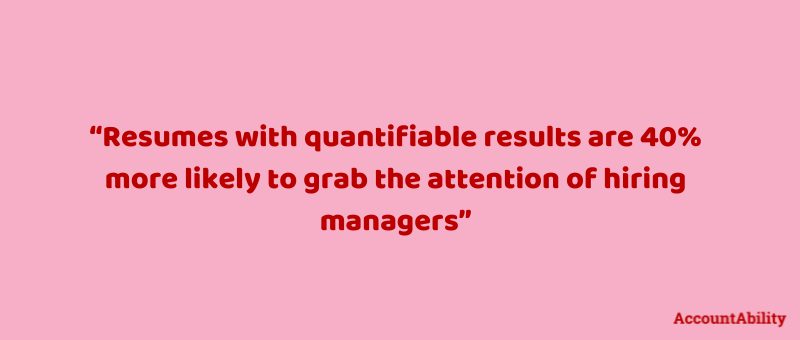.png)
5. Highlight your skills and get endorsed
LinkedIn allows you to list up to 50 skills on your profile, but it’s best to focus on those that are most relevant to your career goals. Make sure to ask colleagues, managers, and clients to endorse these skills, as endorsements add credibility and help validate your expertise.
Why are endorsements important?
Credibility boost: Endorsements from trusted professionals give your profile more weight, showing potential employers that your skills are recognised by others in the field. This validation can make you a more attractive candidate.
Improved visibility: Endorsements can increase your profile’s ranking in LinkedIn’s search results, making you more likely to appear when recruiters are looking for specific skill sets. The more endorsements you have for a skill, the higher the likelihood that your profile will be viewed.
Networking: Asking for endorsements allows you to reconnect with your network, creating a natural way to stay in touch with colleagues and potentially open doors for new opportunities.
Endorsements are a simple yet powerful way to strengthen your LinkedIn profile and enhance your personal brand.
6. Request recommendations
A strong recommendation can really make your profile stand out and add credibility to your personal brand. Recommendations provide third-party validation of your skills and work ethic, and they can give potential employers a more comprehensive view of your professional capabilities.
When asking for recommendations, be strategic and reach out to people who know your work well, such as managers, colleagues, or clients. To ensure the recommendation is impactful, be specific about what you’d like them to highlight. If you’re targeting leadership roles, ask them to focus on your leadership skills. Make sure the recommendation aligns with the skills and experiences relevant to your career goals, especially if you’re transitioning into a new industry or role.
Finally, always show appreciation with a thoughtful thank-you message to acknowledge their support and reinforce your professional relationship.
7. Customise your LinkedIn URL
Having a personalised LinkedIn URL (like linkedin.com/in/yourname) is a small but professional touch. It’s easier to share on resumes and looks polished.
Step 1. Go to your profile
Click on your profile picture in the top menu. From the drop-down menu, select "View Profile".
Step 2. Edit your public profile & URL
On the right-hand side of your profile page, find the section titled "Edit public profile & URL". Click on this option to enter the URL customisation page.
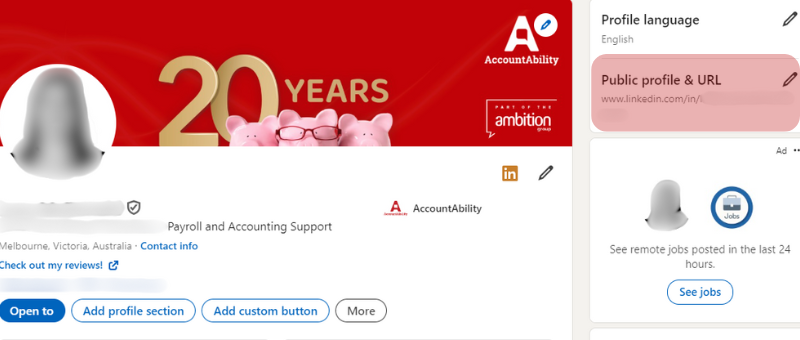
Step 3. Customise your URL
At the top right corner of the new page, there’s an option to "Edit your custom URL". Click the pencil icon next to your current URL.
You’ll see a box where you can input your desired URL. It’s typically best to use a variation of your name (e.g., linkedin.com/in/YourName).
Once you’ve entered your new, customised URL, click "Save".
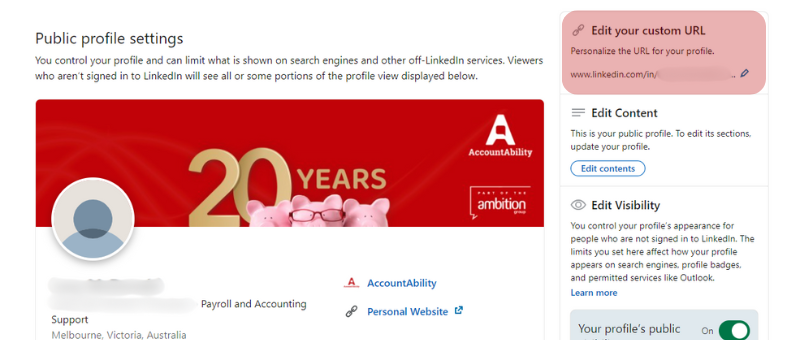.png)
8. Be active and engage
Being active on LinkedIn by sharing posts, commenting on others’ content, and joining group discussions increases your visibility. It also shows potential employers that you’re engaged and knowledgeable in your industry. Follow companies and professionals who align with your career goals and interests, and when connecting with people, always personalise your request by explaining why you want to connect.
Things to avoid when engaging on LinkedIn:
Impersonal connection requests: Sending generic connection requests without a personalised message can make you seem uninterested or transactional. Always add a personal note explaining why you want to connect – this helps establish a more meaningful relationship.
Oversharing or irrelevant content: While it’s important to be active, avoid posting content that’s overly personal or irrelevant to your industry. Focus on sharing insights that contribute to professional discussions.
Spamming comments or messages: Avoid spamming comment sections with self-promotion or sending multiple unsolicited messages to connections. It’s important to engage in meaningful conversations and avoid coming across as pushy.
Negativity or unprofessional behaviour: LinkedIn is a professional platform, so keep interactions positive and constructive. Avoid venting frustrations about previous employers or engaging in online arguments, as this can harm your reputation.
By engaging thoughtfully and strategically, you’ll build a stronger network and create a professional presence that enhances your personal brand.
9. Keep your profile up-to-date
Make sure your LinkedIn profile reflects your most recent skills, achievements, and roles. This shows employers that you’re actively growing and engaged in your career.
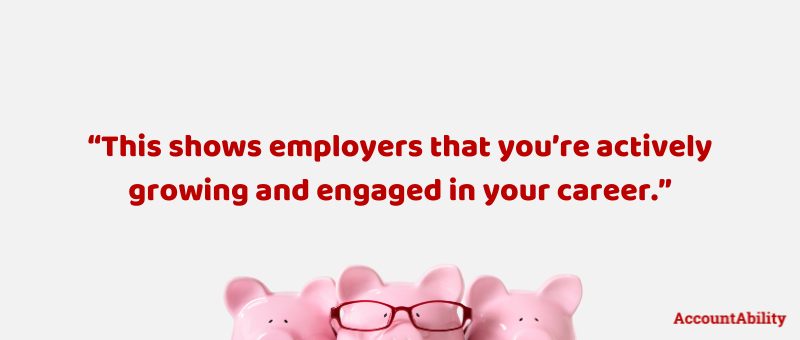.png)
10. Use LinkedIn’s features
Take advantage of features like the ‘Open to Work’ badge, which lets recruiters know you’re open to new job opportunities. You can also showcase your portfolio, certificates, or any projects you’re proud of in the ‘Featured’ section.
Advantages of using the ‘Open to Work’ feature:
Increased visibility to recruiters: When you turn on ‘Open to Work,’ recruiters who use LinkedIn’s hiring tools are more likely to find your profile. This can significantly boost your chances of being discovered for roles that match your skills and experience.
Networking opportunities: By sharing your job-seeking status with your network, you may tap into opportunities through connections who know of available positions or can refer you to potential employers.
Customisation: You can choose to show your availability to all LinkedIn users or just recruiters, allowing you to control your privacy while still signalling to key people that you’re on the market.
How to turn on the ‘Open to Work’ feature:
Go to your profile: Click on your profile picture or name to go to your profile page.
Click on ‘Open to’: Below your profile photo, you’ll see a button labelled ‘Open to.’ Click it.
Select ‘Finding a new job’: Choose the option that best describes your job search. You can specify the types of roles you’re interested in, your preferred locations, and when you’re available to start.
Choose your audience: You can choose to share your status with all LinkedIn members or only with recruiters. If you choose to share with recruiters only, LinkedIn ensures your current employer won’t see it.
Save: After filling out the details, click ‘Save’ to activate the feature.
By leveraging the ‘Open to Work’ feature, you make it easier for recruiters to find you and open yourself up to more opportunities.
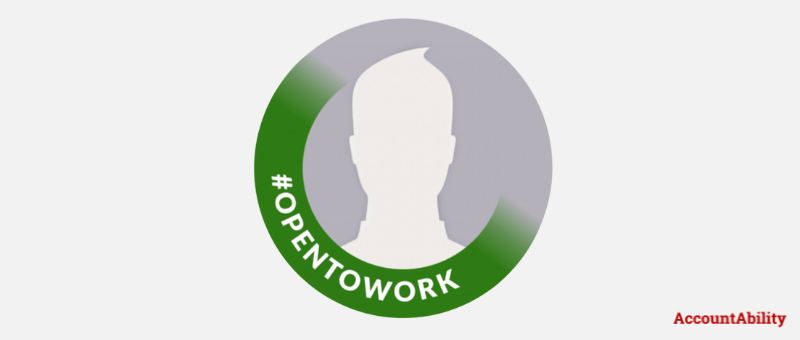.png)
Final thoughts
Your LinkedIn profile is a living document, so keep it fresh as you grow in your career. By following these simple tips, you’ll make sure your profile is ready to catch the eye of hiring managers and represent your professional brand the best it can.
If you need help optimising your LinkedIn profile or navigating your next career move, our team at AccountAbility is here to guide you. Get in touch today, and let’s take your career to the next level!
Other useful resources
In the TEDx Talk below, Austin Henline shares four practical tips for establishing a professional brand and emphasises the importance of utilising LinkedIn for career advancement, demonstrating that success on the platform is attainable for individuals at all experience levels.
Written by Melanie Brown, Marketing Executive, Ambition Group Australia.

